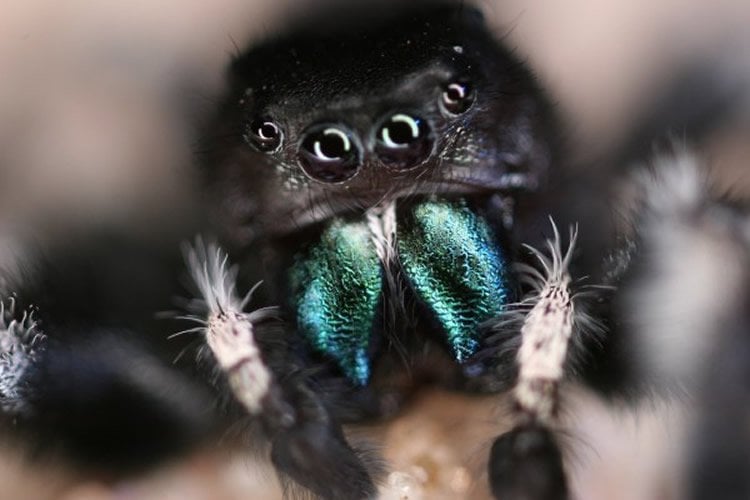Summary: A new study provides evidence that spiders can hear at a distance.
Source: Cornell.
While jumping spiders are known to have great vision, a new Cornell University study proves for the first time that spiders can hear at a distance.
The discovery runs counter to standard textbook wisdom that claimed spiders could only detect nearby sounds.
A study published online Oct. 13 in the journal Current Biology describes how researchers used metal microelectrodes in a jumping spider’s poppy-seed-sized brain to show that auditory neurons can sense far-field sounds, at distances up to 3 meters, or about 600 spider body lengths.
In further tests, researchers stimulated sensitive long hairs on the spider’s legs and body – previously known to pick up near-field airflow and vibrations – which generated a response in the same neurons that fired after hearing distant sounds, providing evidence the hairs are likely detecting nanoscale air particles that become excited from a sound wave.
“We are the first and only lab that has successfully and fully been able to tap into what the spider’s brain is listening to,” said Ron Hoy, Cornell professor of neurobiology and behavior and the senior author of the study.
An interdisciplinary team with researchers from fields of psychology, biological statistics and computational biology, medicine, and physics included the study’s co-first authors, Paul Shamble, a former graduate student in Hoy’s lab who specializes in spiders and is a distinguished science fellow at Harvard University, and Gil Menda, a postdoctoral researcher in Hoy’s lab.
Menda developed the technique for recording the jumping spider’s neural activity.
Standard techniques for studying spider neurology require dissection, which kills the animal because spiders’ bodies are under pressure, so a cut causes the arachnid to quickly bleed and die. Instead, Menda’s method creates a very tiny hole that seals, like a self-sealing tire, around a hair-sized tungsten microelectrode. The electrodes record electrical spikes when neurons fire.
Menda was actually studying visual perception in jumping spiders when his chair squeaked, and neurons suddenly fired. The discovery led him to test reactions to different audio frequencies. He identified an area of the brain that integrates visual and audio stimuli. He also learned the spiders were sensitive to high frequencies and very specific low frequencies, at 90 Hz.
“All the team sat there together and we were thinking, ‘why are they so sensitive to those frequencies?’” Menda said. It turned out 90 Hz is near the same frequency as wing beats of parasitic wasps, the jumping spider’s biggest enemies, which provision their nests with jumping spiders for their young to feed on.

With the help of Ron Miles, professor of mechanical energy at Binghamton University, whose lab has a special quiet room without vibrations, Menda, Miles and undergraduate co-author Katherine Walden ’14, ran experiments with a special cage that allowed them to eliminate vibrations. They used high-speed video and recorded the spider’s behavior when exposed to pulses of sound.
“When we played 90 Hz, 80 percent of the spiders froze” for up to a second, before they turned and jumped, said Menda. By freezing, a classic behavior called a startle response for animals that hear, spiders assess the situation to avoid detection from wasps that scout for movement, before escaping.
umping spiders are highly visual animals. The use vision in courtship and to catch food. Gil Menda in Ron Hoy’s lab at Cornell University developed a technique to record from the brain of a jumping spider. This enabled him to study their vision but also revealed the surprising fact that some brain neurons were sensitive to both visual stimuli and to sound.
The technique opens up studies that link neurology with behavior in all spiders, Hoy said. Menda has since found evidence of hearing in five different spider species: jumping spiders, fishing spiders, wolf spiders, netcasting spiders and house spiders.
Future work by Hoy’s lab will investigate audio perception from lyriform organs and will better investigate audio neurons in the brain. The findings could have applications for using hairlike structures for extremely sensitive microphones, such as in hearing aids.
Funding: The study was funded by the National Institutes of Health and the National Science Foundation.
Source: Daryl Lovell – Cornell
Image Source: NeuroscienceNews.com image is credited to Hoy Lab, Cornell University.
Video Source: The video is credited to Cornell University.
Original Research: Full open access research for “Airborne Acoustic Perception by a Jumping Spider” by Paul S. Shamble, Gil Menda, James R. Golden, Eyal I. Nitzany, Katherine Walden, Tsevi Beatus, Damian O. Elias, Itai Cohen, Ronald N. Miles, and Ronald R. Hoy in Current Biology. Published online August 17 2016 doi:10.1016/j.cub.2016.08.041
[cbtabs][cbtab title=”MLA”]Cornell “Jumping Spiders Can Hear More Than You Think.” NeuroscienceNews. NeuroscienceNews, 13 October 2016.
<https://neurosciencenews.com/spider-hearing-neuroscience-5292/>.[/cbtab][cbtab title=”APA”]Cornell (2016, October 13). Jumping Spiders Can Hear More Than You Think. NeuroscienceNew. Retrieved October 13, 2016 from https://neurosciencenews.com/spider-hearing-neuroscience-5292/[/cbtab][cbtab title=”Chicago”]Cornell “Jumping Spiders Can Hear More Than You Think.” https://neurosciencenews.com/spider-hearing-neuroscience-5292/ (accessed October 13, 2016).[/cbtab][/cbtabs]
Abstract
Airborne Acoustic Perception by a Jumping Spider
Highlights
•We present evidence that jumping spiders, famously visual, perceive airborne sounds
•Spiders responded to low 80 Hz tones by freezing—an acoustic startle response
•Neural recordings revealed units in the brain that respond to airborne acoustic cues
•Neural responses to 80–380 Hz (∼65 dB SPL) persisted at far-field distances (>3 m)
Summary
Jumping spiders (Salticidae) are famous for their visually driven behaviors. Here, however, we present behavioral and neurophysiological evidence that these animals also perceive and respond to airborne acoustic stimuli, even when the distance between the animal and the sound source is relatively large (∼3 m) and with stimulus amplitudes at the position of the spider of ∼65 dB sound pressure level (SPL). Behavioral experiments with the jumping spider Phidippus audax reveal that these animals respond to low-frequency sounds (80 Hz; 65 dB SPL) by freezing—a common anti-predatory behavior characteristic of an acoustic startle response. Neurophysiological recordings from auditory-sensitive neural units in the brains of these jumping spiders showed responses to low-frequency tones (80 Hz at ∼65 dB SPL)—recordings that also represent the first record of acoustically responsive neural units in the jumping spider brain. Responses persisted even when the distances between spider and stimulus source exceeded 3 m and under anechoic conditions. Thus, these spiders appear able to detect airborne sound at distances in the acoustic far-field region, beyond the near-field range often thought to bound acoustic perception in arthropods that lack tympanic ears (e.g., spiders). Furthermore, direct mechanical stimulation of hairs on the patella of the foreleg was sufficient to generate responses in neural units that also responded to airborne acoustic stimuli—evidence that these hairs likely play a role in the detection of acoustic cues. We suggest that these auditory responses enable the detection of predators and facilitate an acoustic startle response.
“Airborne Acoustic Perception by a Jumping Spider” by Paul S. Shamble, Gil Menda, James R. Golden, Eyal I. Nitzany, Katherine Walden, Tsevi Beatus, Damian O. Elias, Itai Cohen, Ronald N. Miles, and Ronald R. Hoy in Current Biology. Published online August 17 2016 doi:10.1016/j.cub.2016.08.041






